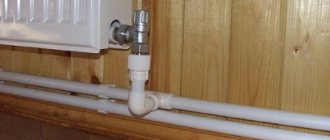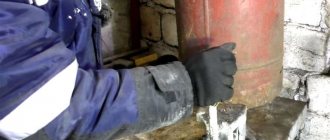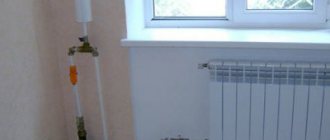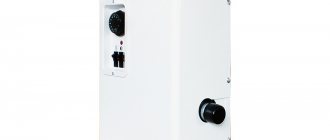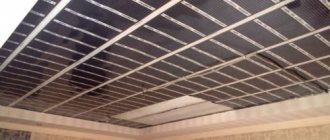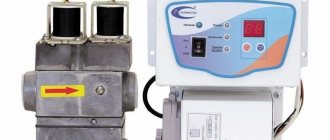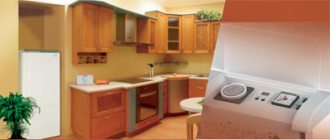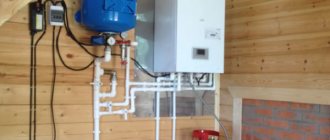The classic heating scheme with one heat generator is well known to every home owner. However, by combining a gas and electric boiler in one system, a much greater practical effect can be achieved. They say that such a connection is much more economical than usual. Sounds tempting, doesn't it?
Logical reasoning raises doubts: how will electricity help save the budget, since its cost is much higher than gas? And why do this at all from the point of view of the feasibility of increasing the power of the units? Isn't it easier to just buy one productive boiler?
In fact, the project of such a combination is quite justified. We will tell you in detail how to assemble heating with electric and gas appliances. You will learn about the structure of this system and its feasibility. We will help you draw up a diagram and not miss the important nuances of arranging a combined heating line.
Why install two boilers at once?
The role of the leader in the gas + electric combination is usually performed by a gas unit. This is logical, if only because of the lower cost of the fuel used in the supply. But the word “save” was mentioned above, and it is not clear what the cost reduction is.
The fact is that in many regions the electricity tariff is based on the day/night system. In some cases, it turns out, at least a little, but more economical than paying for gas. The difference is doubtful, but it can serve as an additional reason to add arguments for the double connective.
Installing an electric boiler in conjunction with a gas boiler can play a backup or additional role in the overall organization of heat supply. When choosing equipment power, you should focus specifically on the purpose of its use.
Of course, this is not such a compelling reason to immediately design a heating system with 2 boilers. The main advantages of the circuit are power amplification and uninterrupted operation. When choosing and installing a heat generator, you must clearly understand that any device and fuel supply are not eternal.
The power supply is turned off, the gas line may be blocked due to a leak, the voltage in the network will drop, or a simple breakdown of the unit itself will occur. In this case, you risk being left without heat and hot water during the cold season.
To ensure uninterrupted operation of heating equipment or increase the power of the system as a whole, it is possible to allow 2 boilers operating on different fuels to operate at once
This is called connecting an additional (to enhance power) or backup power source, depending on the purposes and situations that arise.
How to properly connect two boilers into one system in parallel
Modernizing the heating system in a private home may require installing two boilers at once, connecting them into a common network. What sequence should be followed? How to connect two boilers into one system, which must be taken into account if there is a need to share a gas boiler with a solid fuel, electric boiler or heating equipment running on liquid fuel.
How to connect two boilers together?
I would like to clarify right away that simply connecting two boilers using different types of fuel into one system is one of the possible solutions to the problem of the lack of power of the installed equipment. It is also possible to connect more than two models into one network. For what purposes may you need to connect two boilers to one system? There are several good reasons why this is advisable.
- Lack of power. Incorrect calculation of equipment or additionally added living space can lead to the fact that the boiler power may simply not be enough to maintain normal coolant temperature.
- Increased functionality. It may be necessary to connect two boilers to one system in order, for example, to increase the battery life of the equipment. For example, if the main source of heat is a solid fuel boiler, then for its operation it is necessary to constantly add firewood, which is not always convenient, much less practical. By installing an electric boiler or gas heating device after it, you can solve this situation as follows. As soon as the firewood or coal has burned out and the coolant has begun to cool, additional heating equipment is switched on in the process and continues to heat the room until the owner adds a new batch of firewood in the morning.
As you can see, connecting two heating boilers using different types of fuel is practical; in addition, it may be due to an urgent need associated with a lack of equipment performance.
How to connect two gas boilers in parallel
There are two connection schemes for gas and any other water heating equipment. You can connect two boilers to one heating system:
- Sequentially - in this case, one unit will be installed after another. In this case, the load will be distributed unevenly, since the main boiler will constantly operate at full capacity, which can lead to its rapid failure.
- Parallel. In this case, the heated area will be divided into two parts. Heating will be carried out by two installed boilers at once. Parallel connection of two gas boilers is usually used in cottage houses and buildings with a large heated area.
For parallel connection, it is necessary to install a controller and also develop a cascade control circuit. Only a competent specialist can answer the question of how to connect two gas boilers in each specific case.
How to connect two boilers - gas and solid fuel?
Combining gas and solid fuel boilers into one system is a simpler task, for which it is necessary to take into account the main features that distinguish the operation of these two types of equipment. Models of gas and solid fuel equipment can be installed in one network sequentially. In this case, TT boilers will play the role of the main source of heat supply. The principle of their operation will be that gas equipment will be turned on for heating only if the operation of the main unit for some reason becomes impossible. Also, usually a gas boiler is assigned the task of heating water, of course, if such a function is provided. During the design of such a system, these features must be taken into account. It will also be necessary to coordinate the chosen scheme in the gas sector and obtain all the necessary permits there, including technical conditions and connection design.
How to combine gas and liquid fuel boilers
For safety reasons, for such a connection it is necessary to create conditions under which safe operation of two types of equipment at once is possible. To do this you need to do the following:
- Install a general system for monitoring the operation of water heating equipment. The combined use of liquid fuel and gas boilers implies the installation of common automation. It, in turn, is connected to control sensors, which send a signal to turn on if the main heat source stops working.
- Install control valves. Shut-off valves operating in automatic mode can also be used.
The connection is carried out in a serial or parallel manner depending on the customer's needs. The plan and schematic diagram are drawn up in the design department, after which it is agreed upon by the gas service.
Advantages of installing several boilers on one network
Connect two boilers at the same time: floor-mounted and wall-mounted boilers may be needed if the area of the room has increased sharply as a result of construction work. Even if the equipment was initially purchased with a power reserve, it may not be enough to heat additional rooms of a larger area. In this case, an additional boiler is installed, connected to the general heating system. The advantage of this solution is:
- Possibility of simultaneous control over the operation of all equipment.
- Savings due to the choice of the main type of fuel.
- Possibility of longer operation of equipment.
Practice shows that it is possible to simultaneously install two or more boilers in one network. With each additional element, overall performance and efficiency drops significantly. Therefore, the feasibility of simultaneous installation of four or more units of water heating equipment is completely absent.
avtonomnoeteplo.ru
Possibility of implementing joint connection
Designing a conventional gas-consuming heating system is not so easy. That is, it is easy to create a working scheme, but getting it approved is problematic. The situation with electric boilers is less dire in terms of costs, time and problems with obtaining papers approving the procedure.
And here is the combination of 2 different fuel units. It would seem that you won’t run into problems and will have to go through the authorities for literally years to get permits. But that's not true.
There are no restrictions on the joint use of gas and electric boilers in regulatory documents. However, it is still necessary to coordinate such a project with the gas service and obtain permission if your use of electricity exceeds the established limit in the total capacity of the equipment
In fact, building regulations are quite favorable to such schemes. To be more precise, there are no prohibitions.
Energy and fuel consumption meters are different. Resource consumption is not exceeded, an explosive situation is not provoked - install boilers in compliance with standard standards and installation instructions for each. There shouldn't be any problems.
We remind you that the installation of gas boilers should be carried out in accordance with SP 402.1325800.2018 (and this document is mandatory and not advisory).
Combination boiler installation
Installation and assembly of the combined heating system is carried out by employees of a special organization and the gas service in accordance with the approved project.
Key installation steps:
- Installation of supports with which the device is leveled. They come as standard with the heating unit;
- Connecting the structure to the gas network;
- Connection to the electrical network;
- Installation of gas and water filters;
- Preliminary leak testing and flushing of the water heating system;
- Connecting the device to the heating pipeline;
- Connecting the chimney to the chimney using high-quality steel pipes with a thickness of at least one millimeter or a flexible chimney. The diameter of the pipe must correspond to the size of the flue;
- Test launch of the system and elimination of possible faults;
- Setting up the heating system of the premises.
General view and diagram of the combined boiler
One of the important conditions for installing a combination boiler in the room in which the unit is installed is a supply and exhaust ventilation system. When installing equipment, follow the rules and regulations for installing heating devices.
How to connect 2 boilers in the system?
You can’t just randomly connect 2 devices, the system will either not work or will work incorrectly. It is necessary to use carefully designed and competently designed ones from an engineering point of view.
There are two main connection schemes, these are:
- Sequential , when all elements are connected to each other without additional nodes. In this case, one device will heat the coolant, and the second will reheat it;
- Parallel , in which the devices included in the circuit have 2 connection points and the boilers operate independently of each other.
The sequential system is more suitable for low-power boiler installations and is rarely used.
Serial connection is considered impractical, if only because it is impossible to remove one boiler without affecting the second. In fact, the problem is solved by installing bypasses and shut-off valves, but still parallel connection is preferable
Meanwhile, parallel connection in a single system of gas and electric boilers has many advantages. Therefore, it is used most often, despite the fact that this arrangement requires more materials and is considered more expensive.
In such a device, you can turn off one of the devices at any time and even remove it for replacement or repair, while the second one will continue to operate as normal.
How to make heating with two boilers
Creating a circuit for two heating boilers is associated with the obvious decision to make maximum use of the functionality of diverse types of heating systems for a private home. Today, several connection options are offered:
- gas boiler and electric,
- boiler for solid fuel and electricity,
- solid fuel boiler and gas.
Before you begin selecting and installing a new heating system, we recommend that you familiarize yourself with the brief characteristics of the operation of combined boilers.
Connecting electric and gas boilers
One of the easiest heating systems to operate involves combining a gas boiler with an electric one. There are two connection options: parallel and serial, but parallel is considered preferable, since it is possible to repair one of the boilers, replace and shut down, and also leave only one operating in minimum mode.
Such a connection can be completely closed, and ordinary water or ethylene glycol for heating systems can be used as a coolant.
Connecting gas and solid fuel boilers
The most technically complex option, as it requires careful preparation of the ventilation system and premises for large and fire-hazardous installations. Before installation, read the installation rules separately for gas and solid fuel boilers, choosing the best option. In addition, the heating of the coolant is difficult to control in a solid fuel boiler, and to compensate for overheating, an open system is required, in which excess pressure is reduced in the expansion tank.
Important: a closed system when connecting gas and solid fuel boilers is prohibited and is considered a serious violation of fire safety.
Optimal performance of two boilers can be achieved using a multi-circuit heating system, which consists of two circuits independent of each other.
Connecting a solid fuel and electric boiler
Before connecting, evaluate the technical characteristics of the selected electric boiler and read the instructions. Manufacturers produce models for open and closed heating systems. In the first case, the best option is to focus the operation of two boilers on a common heat exchanger; in the second, it can be easily connected to an already operating open circuit.
Features of parallel connection
Let's take a closer look at what a standard parallel connection diagram for gas and electric boilers looks like:
- Each unit has coolant supply circuits. They join the common line.
- It is imperative that there are safety groups and shut-off valves.
- The return lines, also equipped with shut-off valves, are connected to the other line.
- A circulation pump is installed on the return line (or supply), in front of the unit for combining the piping circuits.
- The lines of both heating units are connected to the collectors.
- An expansion tank is installed on one of the distribution manifolds. A make-up circuit is also connected to its pipe, equipped with a check valve and shut-off valves.
- From the distribution manifolds there are main branches to the heated floor, radiators, boiler, each with circulation pumps and valves for draining the coolant from the system.
This is not a schematic diagram, but only its main features. It gives a general idea of how best to connect an additional electric boiler to the main gas boiler. The assembly option can be complicated and improved, for example, with an automation system and a servo drive.
With a parallel connection, you can also install a hydraulic arrow and an automation unit, but before doing this, carefully consider this decision; installing them is not always advisable
Connection diagram for two boilers with automatic control
Hydraulically no different from the manual system, except for one detail. When connecting two boilers, two check valves appear. A check valve is necessary to eliminate parasitic flows through an idle boiler. There is no need to manually block anything in this system. Highways must always be open. And if one of the boilers does not work, then the pump of the second boiler will inevitably drive the coolant through it. From the place where the boilers are connected to the system, the coolant will move towards the heating system and in a small circle through the idle boiler. The resistance in an area with a non-working boiler is much less than the resistance of the heating system. Much more coolant will be wasted through the area with the boiler turned off than through the heating system, where there will be a shortage of it. Check valves solve this problem. The same problem can be solved using a hydraulic switch, but then this will be a different system and other costs. Check valves can be installed, for example, on the return line.
Important! The valves must work towards each other, then the coolant from the two boilers will move only in one direction, towards the heating system.
For an automatic system for simultaneous operation of two boilers, an additional part will be needed - a thermostat that will turn off the circulation pump if the system has a wood-burning boiler or any other boiler with non-automated loading. It is necessary to turn off the pump at the boiler. Because when the fuel burns out in it, there is no point in wasting coolant through this boiler, interfering with the operation of the second boiler. Which will pick up the work when the first one stops. With the maximum diameter and the highest brand of thermostat to turn off the pump, you will spend no more than 4,000 rubles and get an automatic system.
Manual/automatic control options
Control of the boiler backup system or shutdown of failed ones can be carried out manually or automatically. It is not advisable to leave the system running with one boiler turned off, since the water will continue to circulate.
Imagine what will happen when the cooled return flows in the opposite direction and begins to mix with the supply, cooling the coolant and causing the pump to work in vain.
If for some reason you do not want to equip the boilers with complex devices, you will start the unit yourself. That is, everything is standard: you need to turn on the device - turn all the necessary valves and turn it on. When disconnecting, perform the steps in reverse order.
If you want the backup equipment to start automatically, the system is equipped with automation, thermostats, indoor and outdoor air temperature sensors, coolant temperature sensors, and servos.
In the circuit diagram of the automatic backup start of the heating unit, all shut-off valves must be in the open position. According to the counter scheme, the system is equipped with check valves to avoid parasitic circulation of coolant through a boiler that is not operating at a certain time.
However, despite the convenience, the system can cause certain problems, for example, hydraulic resistance of check valves, causing stress on the pumps, contamination and wear of the devices themselves.
To automatically turn on the heating boiler, the system is equipped with a thermostat, which sends commands to the control unit, depending on the temperature in the house. The switch-on time for night standby use is set on a timer. The circulation pump is turned off using a magnetic starter.
Automation for electric boilers can be built-in, homemade, or purchased separately. However, you should not install it yourself using advice from the Internet, without having the proper skills. Invite a specialist for installation and correct system settings
When choosing a control that will be equipped with an electric boiler installed in parallel with a gas boiler, you should opt for automation if:
- The backup boiler is turned on at night, when it is inconvenient to start it manually.
- In case of long trips from home during the heating season.
- If the gas boiler is unreliable.
In other cases, it is quite possible to use the simplest manual scheme.
Hydraulic arrow in a parallel connection system
A hydraulic arrow is a device that provides hydraulic isolation of flows supplied to individual circuits of the heating system. It plays the role of a buffer tank, receiving the flow of coolant heated by the boilers and distributing it to consumers in a branched system.
Often the volume of coolant required for them differs, the speed of movement of the heated water and its pressure differ. And in the situation under consideration, the movement of heated water from each of the boilers also stimulates its own circulation pump.
When the powerful pump is turned on, the coolant is unevenly distributed throughout the circuits. So, the task of the hydraulic gun is to equalize this pressure. Due to the fact that there is virtually no hydraulic resistance inside it, it will freely receive and distribute coolant flows from both boilers.
Let’s figure out whether it is really necessary in a parallel system for connecting 2 boilers, especially since if you buy and install a hydraulic separator with the help of a specialist, and not with your own hands, the total amount will be unpleasantly surprising.
The device is a piece of pipe with pipes, hollow or with filter meshes to remove bubbles and filter out incoming contaminants. It can be placed in any position, but more often vertically, with an air vent on top and a shut-off valve on the bottom for cleaning. A hydraulic arrow is installed between the boiler and heating circuits
In the classic connection scheme, a hydraulic separator is usually not required, since the conflict of 2-3 pumps can be equalized without this device. Accordingly, if you have 2 boilers that are used exclusively as a backup and there are no more than 3-4 pumps in the system, there is no particular need for it.
But if there are more forced circulation circuits or heating boilers operate simultaneously at full power, it is best to install this device. Again, it is unknown whether you will use the second boiler permanently or only in backup mode, so it is better to be safe.
Conclusions and useful video on the topic
Synchronization of operation and shutdown of boilers in a parallel installation:
Installing 2 heating boilers, gas and electric, is a wise solution to increase the power of heating equipment, as well as for backup heating of the building. Parallel installation of units is not as difficult as it might seem at first.
The main thing is to correctly select the arrangement scheme and correctly calculate the total or reserve power of the equipment. If you are not confident in your abilities and cannot cope on your own, it is best to contact plumbers. They will help you quickly and efficiently install a system for reliable and comfortable heating of your home.
Electric gas boilers
Sometimes, in order to ensure uninterrupted operation of the heating system, an electric boiler is installed in parallel with a gas boiler, which significantly increases the reliability of heating. You can read how two boilers work in one heating system here. Recently, combination boilers have appeared on sale, which can operate on both gas and electricity. Such units are universal and do not stop functioning in the event of power outages or accidents on gas mains.
Of course, there are still not as many models of combined boilers as there are gas or electric ones. It should be noted that gas-electric heating boilers have a rather complex design. Having purchased such a device, it will be necessary to prepare a separate room for it.
Electric gas heating boilers are equipped with a powerful gas burner. If the electric operating mode is started, the water heating heating elements begin to function. The devices are equipped with a program, thanks to which the transition from one mode to another is carried out automatically. There are also models on sale that can simultaneously use both sources: gas and electricity.
A gas-electric boiler is an ideal option for areas with severe frosty winters. After all, the device is equipped with an option that protects the coolant from freezing.
The electric gas heating boiler has the following advantages:
- Compactness. The device has fairly small dimensions.
- High efficiency. The coefficient can reach 97%.
- Economical. When using a combined unit, the cost of producing thermal energy is reduced.
- Reduced environmental load. The equipment causes much less harm to the environment than a gas installation.
- The ability to automatically switch between electricity or gas supply modes.
- The ability to not only heat the home, but also provide hot water.
- Profitability. The cost of combination boilers is quite high, but the purchase of this unit is a profitable investment. Because the installation quickly pays for itself.
